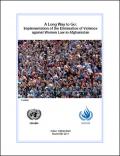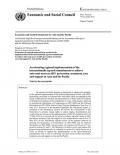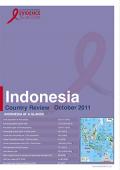What's New
Displaying results 3771 - 3780 of 4914

Resource | Publications,
Human Rights Now (HRN) conducted a survey on violence against women in Cambodia in March 2010 under the 'Violence against Women Project'. The survey was carried out after the adoption of the Law on the Prevention of Domestic Violence and the Protection of Victims (DV Law) at the National Assembly of Cambodia in October 2005, focusing on the situation of domestic violence. Although five years have passed since the introduction of the DV Law, this law is yet to be widely used to provide enough protection for women. It has not been fully enforced. The judiciary who is responsible for the enforcement of the law and women themselves do not completely understand the law. As a result, the legal system is not able to prevent domestic violence and provide adequate protection.
In this research, we investigated the actual situation of domestic violence and how the DV Law has been utilized to prevent it. Where the Law is not functioning properly, the reasons and the solutions were also explored.

Resource | Publications,
Violence against women and girls (VAWG) remains one of the most pervasive yet least recognised human-rights abuses in the world. It is a worldwide problem, crossing cultural, geographic, religious, social and economic boundaries. It exists in the private and public spheres, and occurs in times of peace and conflict.
This report, Men's Attitudes and Practices Regarding Gender and Violence against Women in Bangladesh, is part of The Change Project: Understanding gender, masculinities and power to prevent gender-based violence. It is the first study of its kind in Bangladesh. Interviewing men has provided new knowledge on prevailing social norms, men's attitudes and behaviours – and how they perpetuate violence. Significantly, this study demonstrates that violence is not inevitable and points us in the direction of how to stop violence before it starts.

Resource | Publications,
The Government of Afghanistan took a big step forward in support of women's equality and protection of women's rights when it enacted the Law on the Elimination of Violence against Women (EVAW law) in August 2009. The landmark legislation criminalizes for the first time in Afghanistan child marriage, forced marriage, forced self-immolation and 19 other acts of violence against women including rape, and specifies punishments for perpetrators.
This report examines implementation of the EVAW law by judicial and law enforcement officials throughout Afghanistan for the period of March 2010 to September 2011, and identifies both positive progress and large gaps. The report updates earlier findings on the law's implementation in OHCHR/UNAMA's December 2010 study Harmful Traditional Practices and Implementation of the Law on Elimination of Violence against Women in Afghanistan.

Resource | Fact Sheets,
This issue brief about HIV, harm reduction and the sexual and reproductive health and rights of women who use drugs is part of a series of briefing papers, commissioned by the Global Coalition on Women and AIDS, and is designed to provide up-to-date information around key issues concerning HIV prevention, treatment and care related to women and girls. Harm reduction refers to policies, programmes and practices that aim to reduce the harms associated with the use of psychoactive drugs. The defining features are the focus on the prevention of harm, rather than on the prevention of drug use itself, including a focus on people who continue to use drugs.

Resource | Laws and Policies,
HIV in Nepal is characterized as concentrated epidemic. More than 80 percent HIV infections spread through heterosexual transmission. People who inject drugs, female sex workers (FSWs) and men having sex with other men (MSM) are the key populations at higher risk spreading the epidemic. Male labour migrants (particularly to HIV prevalence areas in India, where labour migrants often visit female sex workers) and clients of female sex workers in Nepal are acting as bridging populations that transmit infections from higher risk groups to lower risk general population. As the epidemic is maturing (after the first HIV case reported in 1988), increased number of infections are being recorded among low risk general men and women. However, the epidemic has never maintained
through heterosexual transmission in the general population in Nepal, rather driven by the infections among higher risk populations and their sexual partners.

Resource | Publications,
The overall aim of the research was to fill gaps in information on HIV and STI prevalence and risk behaviours among MSM and TG in Vanuatu through Integrated Bio‐Behavioural Surveillance (IBBS) and support interventions in Vanuatu. The study was collaboration between the Burnet Institute, Wan Smolbag Theatre and the Vanuatu Ministry of Health. Three research objectives were identified:
1. To estimate the prevalence of chlamydia, gonorrhoea, syphilis and HIV among MSM and TG;
2. To describe knowledge, attitudes and risk behaviours among MSM and TG in Port Vila; and
3. To estimate population size of MSM and TG in Port Vila.

Resource | Publications,
The purpose of the present document is to outline a regional framework that can support Governments in accelerating and monitoring their national efforts towards universal access through regional cooperation, including the sharing of information, experiences and good practices related to the HIV and AIDS response.

Resource | Fact Sheets,
In October 2011, there were 200 new HIV Ab seropositive individuals confirmed by the STD/AIDS Cooperative Central Laboratory (SACCL) and reported to the HIV and AIDS Registry (Table 1). This was 92% higher compared to the same period last year (n=104 in 2010) [Figure 1].

Resource | Reviews and Snapshots,
Since 1987, when the first case of HIV was reported, the rapidly increasing number of new HIV infections in Indonesia makes the epidemic one of the fastest growing in Asia. In 2009, an estimated 310,000 [200,000 - 460,000] adults and children were living with HIV of which an estimated 88,000 [58,000 - 130,000] were women 15 years and older.

Resource | Publications,
Myanmar MICS 2009-2010 was conducted by the Planning Department, Department of Health Planning and the Department of Health. Its main objectives are to provide updated information for assessing the situation of children and women in Myanmar; to furnish data needed for monitoring progress towards the Millennium Development Goals and other internationally agreed goals; and to contribute to the improvement of data collection and monitoring systems in Myanmar.





